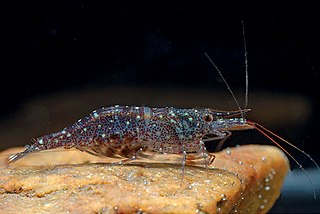Arubolana imula is a species of crustacean in the family Cirolanidae, endemic to Aruba. It was described in 1979 by Lazare Botosaneanu and Jan Hendrik Stock.

Leptostylopsis annulipes is a species of longhorn beetles of the subfamily Lamiinae.
Procaris hawaiana is a species of shrimp in the family Procarididae, from Maui, Hawaii. The species is very similar to Procaris ascensionis from Ascension Island. In P. ascensionis the integument is less firm, the rostrum is shorter, the cervical groove is more distinct, and the third abdominal somite reaches less far posteriorly over the fourth; also the scaphocerite has the final tooth still less distinct than in P. hawaiana, and the last segment of its antennal peduncle is less slender.
Periclimenes pholeter, is a species of shrimp belonging to the family Palaemonidae. The species is closest to Periclimenes indicus, P. obscurus and P. toloensis, resembling these species in the presence of an epigastric tooth on the carapace, the shape of the abdomen, the spinulation of the carapace, and the unarmed fingers of the first chelipeds. P. pholeter most resembles P. indicus by the elongatecarpus and long fingers of the second pereiopods, differing in these features from P. toloensis, which has the fingers slightly less than half as long as the palm. In P. obscurus the fingers are shorter than the palm, but the carpus is about as long as the palm. From P. indicus, this species differs: by the greater size; by the much higher rostrum and the greater number of ventral rostral teeth; by the shorter eye; by the less slender antennular peduncle; by the more deeply cleft upper antennular flagellum; by the more robust scaphocerite; by the fingers of the first pereiopods ; by the more slender pereiopods, especially the fifth, which is much longer than the ischium.

Heteromysis is a genus of marine mysid crustaceans from the family Mysidae, associated with various shallow-water invertebrates. The name describes differentiation of its pereiopods as possible adaptation to commensal life-style. Heteromysis is one of the largest mysid genera, containing more than 100 species. The genus is distributed globally, but predominantly in tropical and subtropical waters.

Armadillidium atticum is a European species of woodlouse endemic to Greece. It is a relatively small species and belongs to the so called "Armadillidium insulanum complex".

Armadillidium sfenthourakisi is a European species of woodlouse endemic to Greece.

Armadillidium maniatum is a European species of woodlouse endemic to Greece.

Armadillidium petralonense is a European species of woodlouse endemic to Greece. It is a relatively medium-sized species that probably belongs to the so-called "Armadillidium fossuligerum complex".

Armadillidium pieperi is a European species of woodlouse endemic to Greece. It is a relatively medium-sized species that probably belongs to the so-called "Armadillidium fossuligerum complex".

Armadillidium jerrentrupi is a European species of woodlouse endemic to Greece. It is a relatively medium-sized species that probably belongs to the so-called "Armadillidium fossuligerum complex".

Paxodillidium is a genus of woodlice endemic to Greece. It is monotypic, being represented by the single species Paxodillidium schawalleri. Its true affinities within the family Armadillidiidae are not known.

Armadillidium teramense is a European species of woodlouse endemic to Italy. It belongs to the "Orthotrigoniae" section of the genus and is currently known only from the type series.

Armadillidium quinquepustulatum is a European species of woodlouse endemic to France. It is a relatively small to medium-sized species that belongs to the so-called "Armadillidium maculatum group".

Armadillidium phalacronum is a European species of woodlouse endemic to Greece. It is a relatively small-sized species that probably belongs to the so-called "Armadillidium insulanum complex".

Armadillidium ruffoi is a European species of woodlouse endemic to Italy.

Armadillidium stymphalicum is a European species of woodlouse endemic to Greece.

Caridina longidigita, also known as the Sulawesi fan shrimp, is a species of freshwater atyid shrimp.
Boreomysis inopinata is a species of mysid crustaceans from the subfamily Boreomysinae. It is also a member of the nominotypical subgenus Boreomysis sensu stricto. The species is a deepwater bathypelagic mysid, found only from the Tasman Sea off Australia.
Boreomysis sibogae is a species of mysid crustaceans from the subfamily Boreomysinae. It is also a member of the nominotypical subgenus Boreomysis sensu stricto. The species is an epi-bathypelagic mysid, widely distributed in the Indo-Pacific and possibly also in the Atlantic Ocean.

















